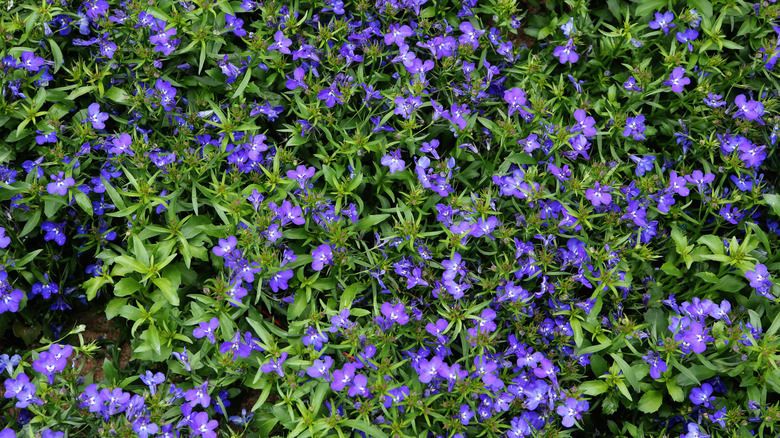Planting Lobelia Will Quickly Fill In Your Patchy Garden Bed With Beautiful Flowers
We all have visions of lush, overflowing flower beds when we start planting, but reality doesn't always quite match the image in our heads. However, you can get a little bit closer to the bountiful flower bed you had in mind with the help of one hardworking plant. If you have a bare patch in your garden, get yourself some lobelia (Lobelia erinus). With delicate flowers that bloom from spring through fall, you will see best results during cooler weather. Still, these fast-growing lobelia plants make great fillers in nearly any outdoor space, and its colorful flowers will attract hummingbirds to your garden.
Lobelia cultivars come in a variety of growing habits — some trail while others are more upright — and prefer full sun or partial shade. They like rich, moist, well-drained soil, and you will often see lobelia mixed into hanging baskets and pots as a colorful filler, even though they are among the flowers that don't always thrive in window box planters. Because it comes in shades of blue, white, pink, and purple there is sure to be a color that fits in your garden's color scheme. Lobelia typically grows to be less than 1 foot tall, but can grow up to 1 foot wide, quickly covering plenty of ground with dense mats of flowers. In most of the U.S., lobelia — sometimes referred to as dwarf lobelia, which separates it from its much taller cousins — is grown as a tender annual, although it is hardy in USDA zones 10 and 11.
Tips for caring for lobelia
Once established, caring for lobelia plants is easy. Heat, however, can be a bit of a problem for these otherwise low maintenance plants. If you expect hot summers, consider planting them in partial shade rather than full sun to give them some protection from the harshest afternoon rays. With a little forethought, this will actually work to your advantage. If you are growing lobelia in a bed with taller plants and flowers, they may be able to provide shade for your lobelia when it needs it most. So plan your beds strategically.
Watering regularly, especially during very hot days or dry spells, can also help your plants cope with the summer heat. If none of that works, however, you can try cutting the plants back by up to a third. Lobelia also flowers best when regularly fertilized. Add a time-release fertilizer when you plant them, and then give them an added boost every 4 to 6 weeks. Continue this even if you end up cutting back your plants, as this will help them regrow and bloom again.

